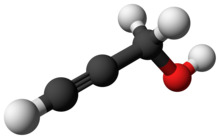 | |
 | |
| Names | |
|---|---|
| IUPAC name Prop-2-yn-1-ol | |
| Other names propynol, 2-propynol, 2-propyn-1-ol, prop-2-yn-1-ol, hydroxymethylacetylene. | |
| Identifiers | |
3D model (JSmol) | |
| ChEBI | |
| ChEMBL | |
| ChemSpider | |
| ECHA InfoCard | 100.003.157 |
| EC Number |
|
| KEGG | |
PubChem CID | |
| RTECS number |
|
| UNII | |
| UN number | 1986 2929 |
CompTox Dashboard (EPA) | |
InChI
| |
SMILES
| |
| Properties | |
Chemical formula | C3H4O |
| Molar mass | 56.064 g·mol−1 |
| Appearance | Colorless to straw-colored liquid[1] |
| Odor | geranium-like[1] |
| Density | 0.9715 g/cm3 |
| Melting point | −51 to −48 °C (−60 to −54 °F; 222 to 225 K) |
| Boiling point | 114 to 115 °C (237 to 239 °F; 387 to 388 K) |
| miscible[1] | |
| Vapor pressure | 12 mmHg (20 °C)[1] |
| Hazards[2] | |
| Safety data sheet | External SDS |
| GHS pictograms |      |
| GHS Signal word | Danger |
GHS hazard statements | H226, H301, H310, H330, H314, H373, H411 |
GHS precautionary statements | P210, P233, P240, P241, P242, P243, P260, P261, P264, P270, P271, P273, P280, P301+310, P301+330+331, P302+352, P303+361+353, P304+340, P305+351+338, P310, P311, P312, P321, P322, P330 |
| NFPA 704 (fire diamond) | |
| Flash point | 36 °C; 97 °F; 309 K (open cup)[1] |
| NIOSH (US health exposure limits): | |
PEL (Permissible) | none[1] |
REL (Recommended) | TWA 1 ppm (2 mg/m3) [skin][1] |
IDLH (Immediate danger) | N.D.[1] |
Except where otherwise noted, data are given for materials in their standard state (at 25 °C [77 °F], 100 kPa). | |
Propargyl alcohol, or 2-propyn-1-ol, is an organic compound with the formula C3H4O. It is the simplest stable alcohol containing an alkyne functional group.[3] Propargyl alcohol is a colorless viscous liquid that is miscible with water and most polar organic solvents.
Reactions and applications
Propargyl alcohol polymerizes with heating or treatment with base. It is used as a corrosion inhibitor, a metal complex solution, a solvent stabilizer and an electroplating brightener additive. It is also used as an intermediate in organic synthesis. Secondary and tertiary substituted propargylic alcohols undergo catalyzed rearrangement reactions to form α,β-unsaturated carbonyl compounds via the Meyer–Schuster rearrangement and others. It can be oxidized to propynal[4] or propargylic acid.
As an indication of the electronegativity of an sp carbon, propargyl alcohol is significantly more acidic (pKa = 13.6) compared to its sp2-containing analog allyl alcohol (pKa = 15.5), which is in turn more acidic than the fully saturated (sp3 carbons only) n-propyl alcohol (pKa = 16.1).[5]
Preparation
Propargyl alcohol is produced by the copper-catalysed addition of formaldehyde to acetylene as a by-product of the industrial synthesis of but-2-yne-1,4-diol.[6] It can also be prepared by dehydrochlorination of 3-chloro-2-propen-1-ol by NaOH.[7]
Safety
Propargyl alcohol is a flammable liquid, toxic by inhalation, highly toxic by ingestion, toxic by skin absorption, and corrosive.
See also
- Alkynylation
- Allyl alcohol
- Propargyl
- Propargyl chloride
References
- ^ a b c d e f g h NIOSH Pocket Guide to Chemical Hazards. "#0527". National Institute for Occupational Safety and Health (NIOSH).
- ^ Record of Prop-2-yn-1-ol in the GESTIS Substance Database of the Institute for Occupational Safety and Health, accessed on 11 March 2020.
- ^ Merck Index, 11th Edition, 7819
- ^ J. C. Sauer (1956). "Propionaldehyde". Organic Syntheses. 36: 66.; Collective Volume, 4, p. 813
- ^ Anslyn, Eric V., 1960- (2006). Modern physical organic chemistry. Dougherty, Dennis A., 1952-. Mill Valley, California: University Science Books. ISBN 1-891389-31-9. OCLC 55600610.
- ^ Falbe, Jürgen; Bahrmann, Helmut; Lipps, Wolfgang; Mayer, Dieter. "Alcohols, Aliphatic". Ullmann's Encyclopedia of Industrial Chemistry. Weinheim: Wiley-VCH. doi:10.1002/14356007.a01_279..
- ^ [1] J. Am. Chem. Soc., 1944, 66 (2), pp 285–287
External links
- [http://nj.gov/health/eoh/rtkweb/documents/fs/1597.pdf Hazardous substance fact sheet for propargyl alcohol
- CDC - NIOSH Pocket Guide to Chemical Hazards
